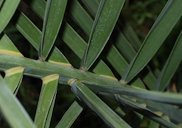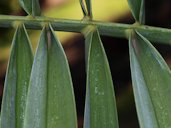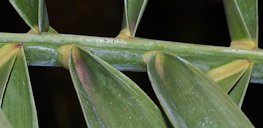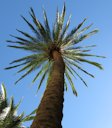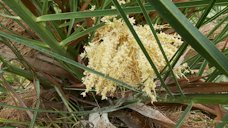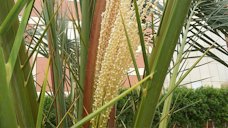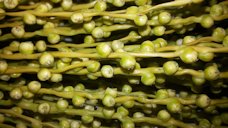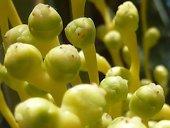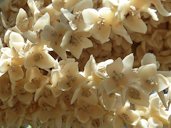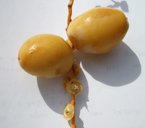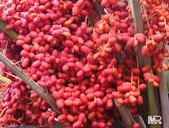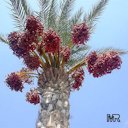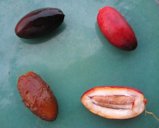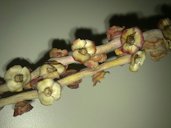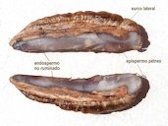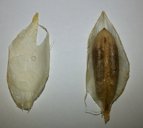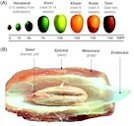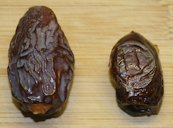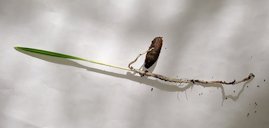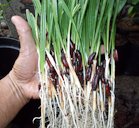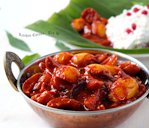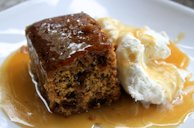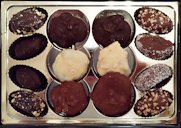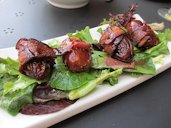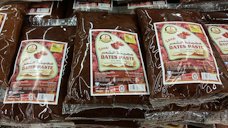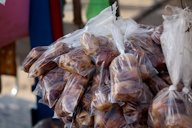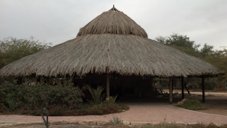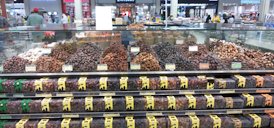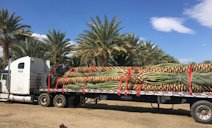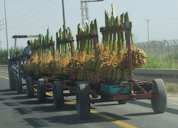| Date Palm - Phoenix dactylifera |
|||||||||||||||||||||||||||||||||||||||||||||||||||||||||||||||||||||||||||||||||||||||
|---|---|---|---|---|---|---|---|---|---|---|---|---|---|---|---|---|---|---|---|---|---|---|---|---|---|---|---|---|---|---|---|---|---|---|---|---|---|---|---|---|---|---|---|---|---|---|---|---|---|---|---|---|---|---|---|---|---|---|---|---|---|---|---|---|---|---|---|---|---|---|---|---|---|---|---|---|---|---|---|---|---|---|---|---|---|---|---|
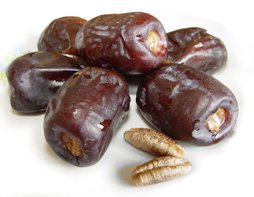 Fig. 1  Phoenix dactylifera, ripe fruit 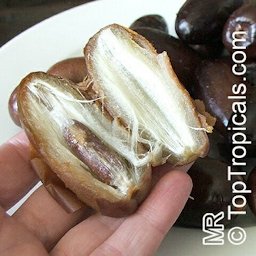 Fig. 2  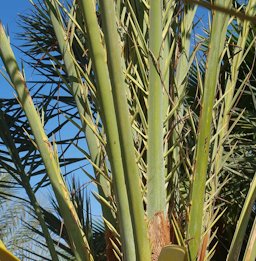 Fig. 3  P. dactylifera leaf rachis and spines 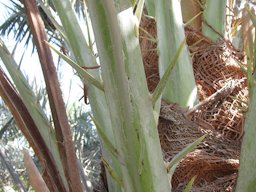 Fig. 4  Date palm spines close-up 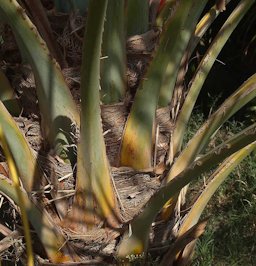 Fig. 5  P. dactylifera leaf bases and fibers 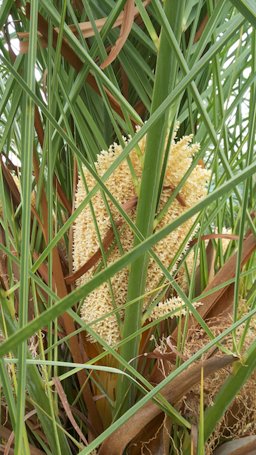 Fig. 11  Male date palm inflorescence, and the whole thing with its cover is called (طَلْع singular form) in Arabic 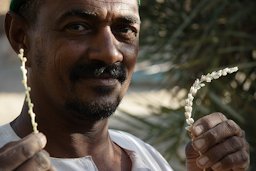 Fig. 12  The female Tamim and the male date flower (تميم) from the Dar al-Manasir region of Northern Sudan, near the Nile 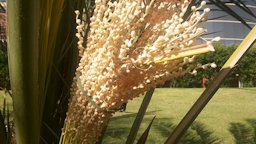 Fig. 13  Pollinated date palm female inflorescence (close-up), at Ajman University of Science and Technology 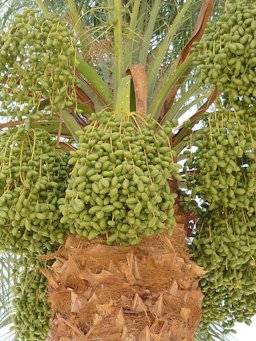 Fig. 19  Immature date fruits, Medinet Habu, Theban Necropolis, Egypt 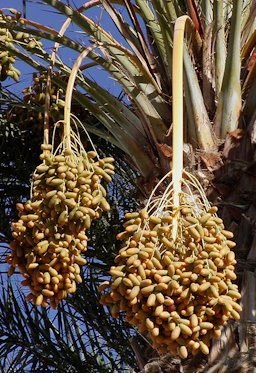 Fig.20  Dates on a date palm in Las Vegas, Nevada 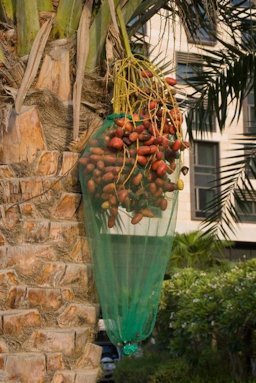 Fig. 21  Specimen of P. dactylifera growing in Adu Dhabi with the infrutescence bagged to collect the ripening dates 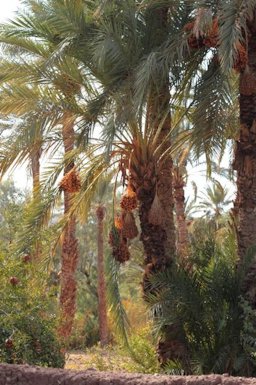 Fig. 33  Mature specimen of P.dactylifera growing in Morocco with fruit clusters (infructescences) hanging below the leaves 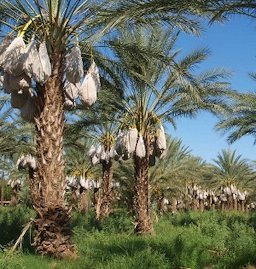 Fig. 34  P. dactylifera field of young individuals in cultivation 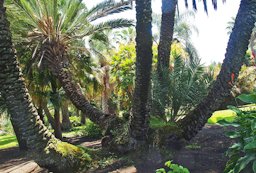 Fig. 38  P. dactylifera older individual with multiple stems 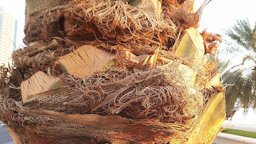 Fig. 39  Date palm bark showing cut leafs and fibers 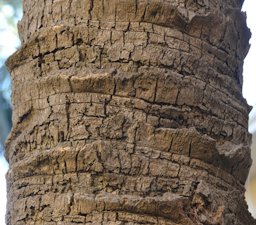 Fig. 40 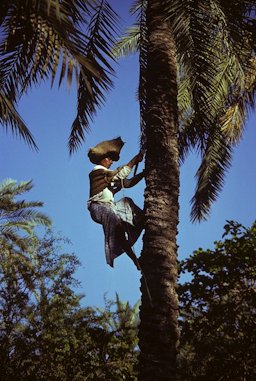 Fig. 41  Date picker, Saudi Arabia 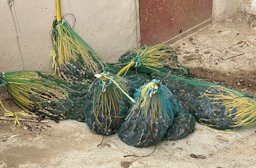 Fig. 42  Bunches of mature dates that have just been harvested in the Al Ain Oasis (UAE) in late summer 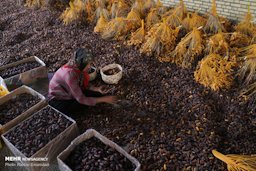 Fig. 43  Growers harvesting Piarom date in Hormozga, southern Iran 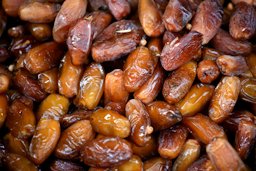 Fig. 44  An assortment of dates, Sydney, Australia 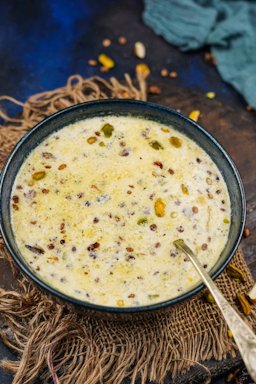 Fig. 45  Sheer khurma (vermicelli milk dates pudding) 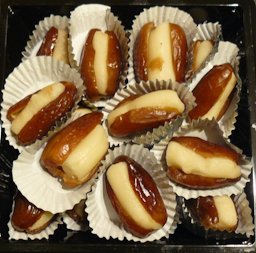 Fig. 46  Dates stuffed with marzipan 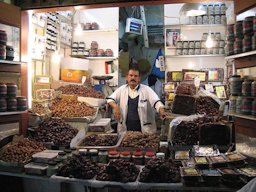 Fig. 56  Date seller in the old souq in Kuwait City, surrounded by dates from Kuwait, Iran, Saudi Arabia and elsewhere Back to Edible Palms |
Scientific
name Phoenix dactylifera L. Common names English: date palm, edible date; Arabic: 枣椰子, شجرة العرب; Chinese: 海枣(植物); Czech: datlovník pravý; Dutch: dadel; French: dattier, palmier dattier; German: Echte Dattel palme; Hindi: खजूर का पेड़, फोनिक्स डेक्टीलिफेरा; Hungarian: datolyapálma; Japanese: ナツメヤシ類, 대추야자 ; Persian: نخلهاي خرما; Italian: palme da datteri; Spanish: palma datilera, almera datilera; Portuguese: tamareira, Polish: Daktyl, Daktylowa palma, Daktylowe drzewo, Daktylowiec właściwy; Russian: пальма финиковая, финик пальчатый, финиковая пальма дланевидная; Slovak: datľovník obyčajný; Turkish: hurma palmiyesi 12 Other Common Names Synonyms Palma dactylifera (L.) Mill.; P. atlantica var. maroccana A.Chev.; P. chevalieri D.Rivera, S. Ríos & Obón; P. dactylifera var. adunca D.H. Christ ex Becc.; P. dactylifera var. costata Becc.; P. dactylifera var. cylindrocarpa Mart.; P. dactylifera var. gonocarpa Mart.; P. dactylifera var. oocarpa Mart.; P. dactylifera var. oxysperma Mart.; P. dactylifera var. sphaerocarpa Mart.; P. dactylifera var. sphaerosperma Mart.; P. dactylifera var. sylvestris Mart.; P. iberica D. Rivera, S.Ríos & Obón 10 Relatives Canary Island date palm (P. canariensis), Senegal date palm (P. reclinata), Wild date plum, India date palm (P. sylvestris) 8 Family Arecaceae/Palmae (palm family) Origin Northern Africa and the Middle East 1 USDA hardiness zones 8-12 8 Uses Edible fruit; landscape specimen; many uses in other countries 3 Height Up to 100 ft (45.7 m) 1 Width Up to 40 ft (12 m) 1 Crown Crown is wide but not very dense (Fig. 10) Plant habit Strong upright trunk; vertical, cylindrical and columnar of the same girth all the way up 10 Growth rate Very slow grower; grows at the rate of 1-1.5 ft (30-45 cm) a year 3 Longevity Will keep on for a century though productivity declines after 60 to 80 years 3 Trunk/bark/branches Gray trunk patterned with diamond-shaped leaf scars; multi-stemmed palm from which the suckers are usually removed to create single stemmed specimens 1 Pruning requirement Many homeowners trim the lower leaves to discourage a fungus that commonly develops in warmer climates Leaves Evergreen; pinnately compound; blue-green to gray-green; to 20 ft (6 m) in length; leaflets are 1-2 ft (0.3-0.6m) long 2 Flowers Orange inflorescences can reach lengths of 4 ft (1.2 m), are heavily branched; bear small white blossoms; grow among the leaves; dioecious thus the male must always be nearby 4,2 Fruit Oblong; 1-3 in. (25-75mm) long; occur in orange or red masses when mature 2 Season In California, dates ripen from late Sept. through Dec. 3 USDA Nutrient Content: Deglet Noor, Medjool pdf Light requirement Full sun; cannot grow in the shade 8 Soil tolerances Neutral and basic (mildly alkaline) soils; can grow in very alkaline and saline soils soils that are well drained 8 pH preference It requires neutral to acidic soils Drought tolerance Although a drought resistant desert plant, the date palm has deep roots that typically seek out subterranean water sources; provide regular irrigation for best look and faster growth 1 Soil salt tolerance Salt-tolerant species 8 Cold tolerance 15°F (-9°C) Plant spacing 30 to 33 ft (9-10 m) apart each way 3 Roots Being a monocotyledon, date palm has no tap root; root system fasciculated and fibrous 10 Invasive potential * None reported Pest resistance Susceptible to lethal yellowing disease, so it is best to avoid planting the palm where the disease is present Known hazard Male trees are extremely allergenic because their pollen is air-borne; plant has spines or sharp edges 7,8 Reading Material Phoenix dactylifera: Date Palm, University of Florida pdf Date, Fruits of Warm Climates Phoenix dactylifera L., Agroforestree Database Growing True Date Palms in South Florida, University of Florida, Miami-Dade County pdf Origin While the native range of this palm is uncertain, it is thought to be indigenous to either North Africa or the Middle East. It is also present in Turkey, Pakistan, and Northwest India, but is thought to have been introduced to these areas long ago through transport. 2 The genus nam Phoenix is the Latin term for the Greek word that means “date palm.” The species name dactylifera means “finger-bearing” and refers to the fruit clusters produced by this palm. Dactylifera is a combination of the Greek word dactylus, or “finger,” and the Latin word ferous, or “bearing.” 2 Another source refers this botanical name to the legendary Egyptian bird, "Phoenix", which lived to be 500 years old, and cast itself into a fire from which it rose with renewed growth (Pliny, 1489; Van Zyl, 1983). This resemblance to the date palm, which can also re-grow after fire damage, makes the bird and the date palm share this name, while "dactylifera" originates from the Hebrew word "dachel" which describes the fruit's shape (Popenoe, 1938). 10 Description Although date palm prefers dry climates, it occurs along rivers and streams and in areas of the desert that have underground water sources. In America, this tree grows well in regions where there is low humidity, although it is found in humid areas like Florida, and where the temperatures do not fall below 15°F. Date palm is slow growing and requires full sun for optimal growth; it can reach heights up to 80 feet. When young, the trunk bears boots (remnant petioles that were attached to the trunk); when mature, the boots wear and become knobby but still show a characteristic spiraling leaf arrangement. 2 People in the Middle East have used the date palm as a main food source for at least 1000 years. It is only in the last several hundred years that it became a global commodity. Today, cultivation of date palm has spread into many other parts of the world including the United States. Currently, there are hundreds of varieties of the date palm, with noticeable differences in fruit characteristics. Only two varieties produce fruit in areas with humidity similar to that of the Gulf Coast region of the United States. 2 The other Phoenix species commonly seen in South Florida tolerate our conditions fairly well. These include the Canary Island date, P. canariensis, the pigmy date, P. roebelenii, the wild date, P. sylvestris, Senegal date, P. reclinata, and various hydrids. 5 Botanical and Systematic Description of Phoenix dactylifera, Food and Agriculture of the United Nations Leaves In younger palms, the stem is covered with narrow, triangular leaf bases of fallen or pruned leaves. With age, multiple stems are formed (unless suckering shoots are pruned); leaf scars spiraling, prominent raised knobs. The large greenish or bluish gray pinnate leaves are typically 18-20 ft (5.5-6.1 m) long by 2 ft (0.6 m) wide. Leaflets are 1-2 ft (0.3-0.6 m) long and arranged in V-shape ranks that run the length of the leaf stem. Leaflets near the base are modified into sharp 3-4 in (7.6-10.2 cm) spines. 1 They have a normal life of 3-7 years. 14 The petiole (stem that attaches the leaf to the trunk) is considered "false" because it contains 3- to 4-inch thorns that are actually modified leaflets. 2
Fig. 6. View of leaflet and waxy bloom Fig. 7. P. dactylifera leaflet attachment Fig. 8. Closer view of leaflet and waxy bloom Root system The lack of roots in the top soil allows other cultures such as wheat, lucerne and vegetables to be inter-cropped. While, the high concentration and deep presence of primary roots allows the date palm to benefit from underground moisture and consequently, unlike most fruit palms, resist water stress and drought conditions. 8 Flowers Dates are formed from flowers on 4 ft (1.2 m) inflorescences that emerge from among the leaves in spring. Inflorescence is produced in the axil of a 1-year-old leaf. Male and female flowers grow on separate plants. Only female plants produce dates and only if a male tree is nearby. 1,14 Small fragrant flowers (the female whitish, the male waxy and cream colored), are borne on a branched spadix divided into 25 to 150 strands 12 to 30 in (30-75 cm) long on female plants, only 6 to 9 in (15-22.5 cm) long on male plants. The spadix is enclosed in a tough spathe that bursts open when the flowers are mature. One large inflorescence may embrace 6,000 to 10,000 flowers. Some date palms have strands bearing both male and female flowers; others may have perfect flowers. As the fruits develop, the stalk holding the cluster may elongate 6 ft (1.8 m) while it bends over because of the weight. 3,14
Fig. 14. A blooming male date palm inflorescence and its pollen Fig. 15. Female date palm inflorescence at Ajman University of Science and Technology, Ajman, UAE Fig. 16. Female date inflorescence Fig. 17. Flores hembra, La Huerta, Albatera, Alicante, España (female flowers) Fig. 18. P. dactylifera: flores macho, La Huerta, Albatera, Alicante, España (male flowers) Pollination Fruit production requires that both female and male trees be present in the same area. Date palm is highly cross pollinated due to its dioecious nature. In commercial plantation, mechanical or hand pollination is done. For this, 2-3 male trees are enough to pollinate 100 female palms. About 2-3 strands of male flowers are inserted between the strands of female flowers. If the male spathes open earlier than female, the pollen is dried and stored for use at a later date. 7 In India, spathes generally emerge during February-March and the flower opening starts during March-April. Although stigma of female flower remains receptive for several days, it is better to pollinate the inflorescence as soon as they crack open. 7 Fruit The fruit is oblong, 1 to 3 in (2.5-7.5 cm) long, dark-brown, reddish, or yellowish-brown when ripe with thin or thickish skin, thick, sweet flesh (astringent until fully ripe) and a single, cylindrical, slender, very hard stone grooved down one side. 3 Dates are not formed in climates that are too cool. When grown in humid tropical climates like Florida, the fruit tends to be of low quality often dropping from the tree before ripening. 1 Dates go through 4 stages of development (Fig. 31): 1) Chimri, or Kimri, stage, the first 17 weeks after pollination: green, hard, bitter, 80% moisture, 50% sugars (glucose and fructose) by dry weight; 2) Khalal stage, the next 6 weeks: become full grown, still hard; color changes to yellow, orange or red, sugars increase, become largely sucrose; 3 ) Rutab stage, the next 4 weeks: half-ripe; soften, turn light brown; some sucrose reverts to reducing sugar which gains prominence; 4) Tamar stage: ripe; the last 2 weeks; in soft dates, the sugar becomes mostly reducing sugar; semi-dry and dry dates will have nearly 50% each of sucrose and reducing sugars. 3
Fig. 22. Unripe fruit Fig. 23. Unripe dates close-up Fig. 24,25. Dates ripening Fig. 26. Dates bought from a street cart in Cairo Fig. 27. Stalks of the date palm after the fruit is plucked from the twigs of branches: note the blend of colours Fig. 28. P. dactylifera seeds Fig. 29. P. dactylifera (palma) - Semilla: corte longitudinal - La Huerta, Albatera, Provincia de Alicante, España Fig. 30. Date palm pit cover (called قِطمِير in Arabic language) Fig. 31. (A) Different fruiting stages of date palm according to DPP (days post-pollination) showing Khalal, Rutab and Tamr, the three edible stages of the fruit (Reprinted from Al-Mssallem et al. by permission from Macmillan Publishers Ltd.: [Nature Communications], copyright (2013)); (B) The anatomy of the date fruit at Tamr stage showing the epicarp, mesocarp, endocarp and seed Varieties There are hundreds of date cultivars, of which only about 60 are widely grown throughout the 15 major date-growing countries. 14 Though no cultivars are well adapted to South Florida, it would be best to choose cultivars reported to be more tolerant of humidity and rain. Julia Morton, in her book Fruits of warm climates, recommends the following: a.) The following cultivars are the most tolerant of humidity and rain: ‘Halaway’, ‘Khadrawy’, and ‘Kaktoom’. b.) The cultivar ‘Medjool’ is intermediate in its tolerance of humidity and rain. c.) The following cultivars are not at all tolerant of humidity and rain, therefore are not good candidates for growing well in South Florida: ‘Zahdi’, ‘Deglet Noor’. It can be noted, unfortunately, that ‘Zahdi’, ‘Deglet Noor,’ and sometimes ‘Medjool’, are the ones most often offered for sale in South Florida. 6
Fig. 32. Two fruits of the date palm, the left is a Medjool date, the right is a Khadrawi (or Hadrawi) date Harvesting In 4 or 5 years, the crown clears the ground and the 1st flowering can be expected. 14 Ordinarily, in palms 5 to 8 years old, the first crop will be 17.5 to 22 lbs (8-10 kg) per palm; at 13 years, 132 to 176 lbs (60-80 kg). Some improved cultivars, at high densities, have yielded over 220 lbs (100 kg) per year. 3 Whole dates are harvested and marketed at three stages of their development (Khalal, Rutab and Tamar) depending on variety, climatic conditions and market demand. 9 Propagation Date palms grow readily from seeds if the seeds and seedlings are kept constantly wet. But seedlings are variable and take 6 to 10 years to fruit. Furthermore, 50% of the seedlings may turn out to be males. Propagation is usually done by trunk suckers, which may be carefully removed from the mother tree. After the fourth or fifth year of a palm's life, the owner can usually take at least two offshoots a year from it for a period of ten years. 17 Propagation from seed is done when there are no mature mother trees in the locality; this poses no particular problems but takes longer. The seeds are sown in containers and the young seedlings grown in the nursery for about 1 year before planting out in the field. 14 It is important that male trees are planted with females in ratios of about 1:50. Suckers from quality trees are in high demand for their guaranteed quality. 14
Fig. 35. Germination of date palm Fig. 36. Date palm seedlings in hand Fig. 37. Mansuri cutting offshoots called Shatla (شتلا) from the lower trunk of a parent palm tree in Dar al-Manasir, Northern Sudan Date Palm Propagation, Food and Agricultural Organization of the United Nations Climatic Requirements Date palm is very exacting in its climatic requirement, which according to an Arab saying should grow with its feet in running water and its head in the fire of the sky. The successful cultivation of date palm requires a long summer with high day as well as night temperature, a mild winter without frost, and absence of rain at the time of flowering and fruit setting with low relative humidity and plenty of sunshine. It is estimated that finest date varieties require 3,300 units of heat (base 10 °C) for full maturity of its berries. 7 Planting Deep, sandy loam soils ideal for maximum water–holding capacity and good drainage are desirable. Date palm can grow in alkaline and saline soils but in such soils its growth and productivity are greatly reduced. The soil profile should be free from stones of calcium carbonate concretions and hard pan at least up to 2 m depth. Date palm tolerate high soil salinity (pH 8-10). It can survive in soils having 4 % salt concentration, provided the root system does not come in contact with a stratum of soil where the sodicity is more than 1%. 7 Its high salt tolerance is largely attributable to its chloride ions exclusion ability during water absorption from saline soils this however reduces growth and results in poor quality fruits. 14 Pruning Some minor upkeep may also be required, and many homeowners trim the lower leaves to discourage a fungus that commonly develops in warmer climates. 2 Phoenix dactylifera which is a multi-stemmed palm (Fig. 38) from which the suckers are usually removed to create single stemmed specimens. Trimmed in this manner the date palm will grow to heights of 100 ft (45.7 m). 7 Fruit Thininng Fruit thinning is necessary to ensure adequate flowering in the following year, to improve fruit quality, prevent delayed ripening and reduce compactness and increase ventilation of the bunches. Thinning can be done manually of by chemical sprays. Manual method is common which involves removal of some bunches or strands from each bunch or shortening the length of strands. The number of fruit that a palm can sustain depends on variety, age, vigour and number of green leaves. Three to four bunches/palm is recommended from fifth year onwards. In India 8-10 bunches are left on each palm. The best results are obtained by removing one third strands from the centre of the bunch. However, in long stranded variety, Deglet Noor, shortening of the strands is also necessary. 7 Fertilizing Potassium Deficiency in Palms, University of Florida pdf Potassium Deficiency of Palms in Hawai'i, University of Hawai'i at Mānoa pdf Magnesium Deficiency in Palms, University of Florida pdf Irrigation Irrigation is very essential in date palm because it is grown in hot and dry, low rainfall areas. Further, the water requirement of date palm is high although it can withstand prolonged droughts. Date palm likes wet feet but is damaged under prolonged stagnation. 7 Pests Unripe fruits are attacked by Coccotrypes daclyliperda which makes them fall prematurely. Ripe fruits are often infested by nitidulids—Carpophilus hemipterus, C. multilatus (C. dimidiatus), Urophorus humeralis, and Heptoncus luteolus, which cause decay. 3 Diseases This species is susceptible to Lethal Yellowing disease and should not be planted where other palms are suffering from this always fatal disease. 1 Lethal yellowing (LY) is a phloem-limited disease caused by a phytoplasma and transmitted by a planthopper. Palms with greater than 25% leaf discoloration or a dead apical meristem (bud) due to LY should be removed. 16 It is also susceptible to Lethal bronzing disease (LB) used to be called Texas Phoenix Palm Decline (TPPD). Lethal bronzing (LB) is caused by a phytoplasma—a type of bacteria that lacks a cell wall and cannot be cultured with artificial media. The LB phytoplasma is similar to but genetically distinct from the phytoplasma that causes lethal yellowing (LY) disease of palms. The LB phytoplasma is limited to the phloem (sap) of the palm and cannot survive outside a plant or insect; therefore, it cannot be mechanically transmitted (e.g., by pruning tools or infected roots touching new roots). Once a palm shows symptoms and tests positive for the LBD phytoplasma, it should be removed immediately. 15 The length of time between infection and symptom development (latent period) appears to be about four to five months. From symptom development to collapse of spear leaf is about two to three months, but this is highly variable. 15 Lethal Yellowing (LY) of Palm, University of Florida pdf Lethal Bronzing Disease (LB), University of Florida pdf Food Uses Dry or soft dates are eaten out-of-hand, or may be seeded and stuffed, or chopped and used in a great variety of ways: on cereal, in pudding, bread, cakes, cookies, ice cream, or candy bars. 3 Fruit is of singular importance, as it is a staple part of the diet of millions of people: sap from tapped inflorescence used to make sugar (non destructive). 11 The seeds are roasted and kernels ground as a coffee substitute. Terminal bud leaves are eaten as a vegetable. 14
Fig. 47. Yellow dates, raw dates pickle Fig. 48. Fresh dates and apple crumble Fig. 49. Sticky date pudding with toffee and single malt scotch sauce Fig. 50. Chocolate-coated dates Fig. 51. Bacon-wrapped dates, Highlands Kitchen, Edmonton, AB, Canada Fig. 52. Pumpkin date shake, Las Vegas Fig. 53. Dates paste, product of Saudi Arabia Fig. 54. Vente de dattes à Dakar (Sénégal) à l'occasion du Ramadan Fig. 55. Date syrup, Chapel Hill, North Carolina, USA Medicinal Uses ** Each individual tree is either a male or a female (as is true for all species within this genus). Male trees are extremely allergenic because their pollen is air-borne, whereas the female palms cause minimal to no allergies. 2 The fruits are used to treat respiratory diseases and fevers. Gum obtained from the tree is used to treat diarrhea. 8 Other Uses Date palm makes an attractive landscape specimen with its blue-green leaves, textured trunk, and bright orange inflorescences. 2 The seeds (stones) when ground and softened by soaking in water are used for feeding camels, goats and horses and have successfully been substituted as a poultry feed. 14 Seed oil is used in soap making and in cosmetics. The leaves are used as thatching material (Fig. 59). It yields fiber which can be used to make ropes, baskets, hats, and mats. The wood is strong and resistant to termite attacks. It is used in construction and for fuel. 8 Wherever fruiting is poor, the sap is the main product. It can be drunk fresh, fermented and drunk as toddy, or distilled and drunk as arrack (Fig. . The yield of sap varies with management and site conditions, but it is in the range of 4-8 l/day (Fig. 57,58). 14 Being a halophytic species, P. dactylifera has been used for decades for the revegetation of salt affected lands in the Mediterranean region. 14
Fig. 57. The sweet sap is tapped from date palm tree in Nadia district, West Bengal, India; Jaggery is made from this sweet sap Fig. 58. Taki, West Bengal, note the shape of the tree after many sap tappings Fig. 59. Shack made of date branches at Neot Semadar, Israel Fig. 60. Arrack, Extra special, 40%, Ratgama Hegoda, Southern, Sri Lanka Date Products and Preparations, Food and Agriculture of the United Nations General In Italy, there are some groves of date palms maintained solely to supply the young leaves for religious use on Palm Sunday. In Spain, only the leaves of male palms are utilized for this purpose. 3 In North Africa, they are commonly used for making huts. Mature leaves are also made into mats, screens, baskets and fans. Processed leaves can be used for insulating board. Dried leaf petioles are a source of cellulose pulp, used for walking sticks, brooms, fishing floats and fuel. Leaf sheaths are prized for their scent, and fibre from them is also used for rope, coarse cloth, and large hats. The leaves are also used as a lulav in the Jewish holiday of Sukkot. 13
Fig. 61. Dates at Carrefour, United Arab Emirates Fig. 62. Truck load of P. dactylifera Medjool date palms Fig. 63. Orchard gate made with palm tree boards, Timimoun, Adrar, Algeria Fig. 64. Transport of dates from harvesting site in Israel Fig. 65. Ancient glassware in the Art Institute of Chicago (1st/2nd-century date-shaped glass balsam jars) Fig. 66. Joyous Festivals 5720 stamp, The Seven Species: "A land of wheat, and barley, and vines, and fig trees, and pomegranates; a land of oil olive, and honey" Deuteronomy VIII, 8 Further Reading Date Palm (Phoenix dactylifera), Fruitipedia Phoenix dactylifera L., Handbook of Energy Crops The Date, Manual of Tropical and Subtropical Fruit Date Palm Botanical Art List of Growers and Vendors |
||||||||||||||||||||||||||||||||||||||||||||||||||||||||||||||||||||||||||||||||||||||
| Bibliography 1 Sheper, John. "Phoenix dactylifera." Floridata, Created 22 May 1999, Updated 30 May 1999, floridata.com. Accessed 12 Apr. 2014. 2 Friedman, Melissa H., et al. "Phoenix dactylifera, Date Palm." School of Forest Resources and Conservation, UF/IFAS Extension, FOR 252, Original pub. May 2010, Reviewed Apr. 2016, AskIFAS, edis.ifas.ufl.edu/publication/FR314. Accessed 27 Apr. 2017, 3 Sept. 2022. 3 Fruits of Warm Climates. Julia F. Morton, Miami, 1987. 4 Anderson, P. J. "Phoenix dactylifera." Identifying Commonly Cultivated Palms, a Resource for Pests and Diseases of Cultivated Palms, Florida Department of Agriculture and Consumer Service, Division of Plant Industry and Identification Technology Program, CPHST, PPQ, APHIS, USDA; Fort Collins, CO., 2011, iidtools.org/id/palms/palmid/. Accessed 15 Jan. 2014. 5 Zaid, A., et al. "Diseases and Pests of Date Palm." Date Palm Cultivation: Chapter XII, Food and Agriculture Organization of the United Nations, Rome, 2002, FAO, fao.org. Accessed 27 Apr. 2014. 6 Garofalo, Joe, and Vedae, Jalil (Jay). "Growing True Date Palms in South Florida." UF/IFAS Extension Miami-Dade, Fact sheet no. 61, 2002, AskIFAS, edis.ifas.ufl.edu. Accessed 26 July 2014. 7 Pal, R. N. "Date Palm (Phoenix dactylifera)." Indian Council of Agricultural Research, Krishi Bhawan, New Delhi, India, Fruitipedia, fruitipedia.com. Accessed 21 Nov. 2015. 8 Fern, Ken. "Phoenix dactylifera." Plants For A Future, pfaf.org/User/Plant.aspx?LatinName=Phoenix+dactylifera. Accessed 26 Aug. 2022. 9 Zaid, A., and P. F. de Wet. "Botanical and Systematic Description of the Date Palm." Date Palm Cultivation: Chapter I, Food and Agriculture of the United Nations. Rome, 2002, FAO, fao.org. Accessed 12 Apr. 2015. 10 "Phoenix dactylifera L." The Plant List, theplantlist.org. Accessed 23 Nov. 2015. 11 Haynes, Jody, and John McLaughlin. "Edible Palms and Their Uses." UF/IFAS Extension Miami-Dade, Fact sheet no. 61, 2000, AskIFAS, edis.ifas.ufl.edu. Accessed 14 Dec. 2015. 12 "Phoenix dactylifera." AGROVOC Multilingual Thesaurus, Created 20 Nov. 2011, Last Modified 7 Oct. 2021, FAO, agrovoc.fao.org/browse/agrovoc/en/page/c_5791. Accessed 26 Aug. 2022. 13 "Date Palm." Wikipedia, May 2009, wikipedia.org. Accessed 9 May 2014. 14 Orwa, C., et al. "Phoenix dactylifera L." Agroforestree Database: a tree reference and selection guide, version 4.0., 2009, Agroforestry, apps.worldagroforestry.org/treedb2/speciesprofile.php?Spid=1280. Accessed 29 Aug. 2022. 15 Bahder, Brian W., and Ericka E. Helmick. "Lethal Bronzing Disease (LB)." Plant Pathology Dept., UF/IFAS Extension, PP243, Original pub. Nov. 2007, Revised May 2019 and June 2022, AskIFAS, edis.ifas.ufl.edu/publication/PP163. Accessed 3 Sept. 2022. 16 Bahder, Brian W., and Ericka E. Helmick. "Lethal Yellowing (LB) of Palm.." Plant Pathology Dept., UF/IFAS Extension, PP243, Original pub. Nov. 2007, Revised May 2019 and June 2022, AskIFAS, edis.ifas.ufl.edu/publication/pp146. Accessed 3 Sept. 2022. 17 Popenoe, Wilson. Manual Of Tropical And Subtropical Fruits. 1920, London, Hafner Press, 1974. Photographs Fig. 1 Mariluna. "Dates." Wikimedia Commons, 1 Jan. 2015, GFDL, (CC BY-SA 3.0), commons.wikimedia.org/wiki/File:Phoenix_(botanical)_финики.jpg. Accessed 4 Sept. 2022. Fig. 2,22,23,24 MR. "Phoenix dactylifera." Top Tropicals, toptropicals.com. Accessed 16 Jan. 2014. Fig. 3,4,5,6,7,8,33,37 Anderson, Patti, J. "Phoenix dactylifera." Identifying Commonly Cultivated Palms, a Resource for Pests and Diseases of Cultivated Palms, Florida Department of Agriculture and Consumer Service, Division of Plant Industry and Identification Technology Program, CPHST, PPQ, APHIS, USDA; Fort Collins, CO. 2011, iidtools.org/id/palms/palmid/. Accessed 16 Jan. 2014. Fig. 9,10,39 C. Stubler, et al. "Phoenix dactylifera." SelecTree, A Tree Selection Guide, CalPoly, selectree.calpoly.edu/tree-detail/1002. Accessed 29 Aug. 2022. Fig. 11 Ahmed1251985. "Male Date palm inflorescence, and the whole thing with its cover called (طَلْع singular form) in Arabic." Wikimedia Commons, 27 Jan. 2016, (CC BY-SA 4.0), commons.wikimedia.org/wiki/File:A_male_date_palm_inflorescence.jpg. Accessed 4 Sept. 2022. Fig. 12 Haberlah, David. "The female Tamim and the male date flower (تميم) from the Dar al-Manasir region of Northern Sudan, near the Nile." Wikimedia Commons, via Flickr, 15 June 2005, (CC BY-SA 3.0), commons.wikimedia.org/wiki/File:MaleFemaleDate.jpg. Accessed 2 Sept. 2022. Fig. 13 Ahmed1251985. "Pollinated date palm female inflorescence (close-up), at Ajman University of Science and Technology." Wikimedia Commons, 27 Feb. 2016, (CC BY-SA 4.0), commons.wikimedia.org/wiki/File:Phoenix_dactylifera_inflorescens_10.jpg. Accessed 2 Sept. 2022. Fig. 14 Ahmed1251985. "A blooming male date palm inflorescence and its pollen." Wikimedia Commons, 27 Jan. 2016, (CC BY-SA 4.0), commons.wikimedia.org/wiki/File:Phoenix_dactylifera_inflorescens_10.jpg. Accessed 2 Sept. 2022. Fig. 15 Ahmed1251985. "Female date palm inflorescence at Ajman University of Science and Technology, Ajman, UAE." Wikimedia Commons, 24 Feb.2016, (CC BY-SA 4.0), commons.wikimedia.org/wiki/File:Female_date_palm_inflorescence.jpg. Accessed 2 Sept. 2022. Fig. 16 Ahmed1251985. "Female date inflorescence." Wikimedia Commons, 18 Feb.2016, (CC BY-SA 4.0), commons.wikimedia.org/wiki/File:Female_date_inflorescence.jpg. Accessed 2 Sept. 2022. Fig. 17 Philmarin. "Phoenix dactylifera, flores hembra, La Huerta, Albatera, Provincia de Alicante, España." Wikimedia Commons, 15 May 2012, (CC BY-SA 3.0), commons.wikimedia.org/wiki/File:Phoenix_dact.-florfem-1.jpg. Accessed 2 Sept. 2022. Fig. 18 Philmarin. "Phoenix dactylifera (palma), flores macho, La Huerta, Albatera, Provincia de Alicante, España." Wikimedia Commons, 11 May 2012, (CC BY-SA 3.0), commons.wikimedia.org/wiki/File:Phoenix_dact.-flormasc-1.jpg. Accessed 2 Sept. 2022. Fig. 19 Rémih, I. "Date fruits, Medinet Habu, Theban Necropolis, Egypt." Wikimedia Commons, 8 June 2009, (CC BY-SA 3.0), commons.wikimedia.org/wiki/File:Medinet_Habu_date_palm2.JPG. Accessed 4 Sept. 2022. Fig. 20 Shebs, Stan. "Photo of dates on a date palm in Las Vegas, Nevada." Wikimedia, 2004, wikimedia.org. Accessed 23 Nov. 2015. Fig. 21 Sericea. "Specimen of Phoenix dactylifera growing in Abu Dhabi with infructescence bagged to collect the ripening dates." Flickr, 2011, www.flickr.com. Accessed 15 Apr. 2014. Fig. 23 Chaojoker. "Unripe dates." Wikimedia Commons, 1 Sept. 2012, (CC BY-SA 3.0), Image cropped, commons.wikimedia.org/wiki/File:Անհաս_արմաւ.JPG. Accessed 4 Sept. 2022. Fig. 26 Zachbe. "I took this photo of dates I bought from a street cart in Cairo." Wikipedia, via English Wikipedia, 11 Nov. 2008, GFDL, (CC BY-SA 3.0), Image cropped, en.wikipedia.org/wiki/File:Freshdates.JPG. Accessed 26 Aug. 2022. Fig. 27 Kumarpramod5. "Stalks of the date palm after the fruit is plucked from the twigs of branches: as decorations." Wikimedia Commons, 8 Mar. 2013, (CC BY-SA 3.0), commons.wikimedia.org/wiki/File:Date_Palm_-_ഈന്തപ്പന_10.JPG. Accessed 2 Sept. 2022. Fig. 28 Beckman, Mariana P. "Phoenix dactylifera seeds." DPI, Identifying Commonly Cultivated Palms, a Resource for Pests and Diseases of Cultivated Palms, 2011, iidtools.org/id/palms/palmid/. Accessed 26 Aug. 2022. Fig. 29 Philmarin. "Phoenix dactylifera (palma) - Semilla: corte longitudinal - La Huerta, Albatera, Provincia de Alicante, España." Wikimedia Commons, 12 Apr. 2014, (CC BY-SA 4.0), commons.wikimedia.org/wiki/File:Germination_of_Date_Palm.jpg. Accessed 2 Sept. 2022. Fig. 30 Ahmed1251985. "Date palm pit cover (called قِطمِير in Arabic language)." Wikimedia Commons, 14 Jan. 2016, (CC BY-SA 4.0), Image cropped, commons.wikimedia.org/wiki/File:Date_palm_pit_cover.jpg. Accessed 4 Sept. 2022. Fig. 31 Ghnimi, Sami, et al. "Different fruiting stages of date palm according to DPP* (days post-pollination)." Date fruit (Phoenix dactylifera L.): An underutilized food seeking industrial valorization, NFS Journal, Volume 6, Mar. 2017, pp 1-10, ScienceDirect, (CC BY-NC-ND 4.0), doi.org/10.1016/j.nfs.2016.12.001. Accessed 5 Sept. 2022. Fig. 32 Lon, J. P. "Two fruits of the Date Palm, The Left is a Medjool date, the right is a Khadrawi (or Hadrawi) date." Wikimedia Commons, 11 July 2007, GFDL, (CC BY-SA 4.0), (CC BY-SA 3.0), (CC BY-SA 2.5), (CC BY-SA 2.0), (CC BY-SA 1.0), Image cropped, commons.wikimedia.org/wiki/File:Date_Fruits-Duo.jpgg. Accessed 4 Sept. 2022. Fig. 33 Multivac42. "Mature specimen of P. dactylifera growing in Morocco with fruit clusters (infructescences) hanging below the leaves." UF/IFAS Extension, AskIFAS, (CC BY-NC-ND 2.0), edis.ifas.ufl.edu. Accessed 23 Nov. 2015. Fig. 35 Frolov, Sergei. "Germination of date palm." Wikimedia Commons, 6 June 2019, (CC BY-SA 4.0), commons.wikimedia.org/wiki/File:Germination_of_Date_Palm.jpg. Accessed 2 Sept. 2022. Fig. 36 Srianix. "Date palm seedlings in hand." Wikimedia Commons, 1 Jan. 2012, (CC0 1.0), Image cropped, commons.wikimedia.org/wiki/File:Date_palm_seedlings.jpg. Accessed 4 Sept. 2022. Fig. 37 Haberlah, David. "Mansuri cutting offshoots called Shatla (شتلا) from the lower trunk of a parent palm tree in Dar al-Manasir, Northern Sudan." Wikimedia Commons, via English Wikipedia, 15 June 2005, GFDL, (CC BY-SA 3.0), commons.wikimedia.org/wiki/File:Shatla.JPG. Accessed 2 Sept. 2022. Fig. 39 Ahmed1251985. "Date palm bark showing cut leafs and fibers." Wikimedia Commons, 21 Jan. 2016, (CC BY-SA 4.0), commons.wikimedia.org/wiki/File:Date_palm_bark.jpg. Accessed 2 Sept. 2022. Fig. 41 Dolce, Mark. "Date Picker, Saudi Arabia." Wikimedia Commons, via Flickr, 15 Mar. 2009, (CC BY 2.0), commons.wikimedia.org/wiki/File:Date_Picker,_Saudi_Arabia.jpg. Accessed 2 Sept. 2022. Fig. 42 Slywire. "Bunches of mature dates that have just been harvested in the Al Ain Oasis (UAE) in late summer." Wikimedia Commons, 8 Aug.2020, (CC BY 2.0), Image cropped, commons.wikimedia.org/wiki/File:AlAinOasis_HarvestedDates.jpg. Accessed 4 Sept. 2022. Fig. 43 Emancadi, Pahbar. "Growers harvesting Piarom date in Hormozgan." Mehr News Agency, 26 Oct. 2019, Wikimedia Commons, (CC BY 4.0), commons.wikimedia.org/wiki/File:Growers_harvesting_Piarom_date_in_Hormozgan_2019-10-26_27.jpg. Accessed 4 Sept. 2022. Fig. 44 ProMios, Alex. "An Assortment of Dates from Sydney, Australia." Wikimedia Commons, 3 Jan. 2010, (CC BY 2.0), commons.wikimedia.org/File:An_Assortment_of_Dates_(4257198208).jpg. Accessed 4 Sept. 2022. Fig. 45 Mathur, Neha. "Sheer Khurma (Vermicelli Milk Dates Pudding)." Wisk Affair, 11 apr. 2021, www.whiskaffair.com/sheer-khurma-sheer-korma-recipe/. Accessed 4 Sept. 2022. Fig. 46 MOs810. "Dates stuffed with marzipan." Wikimedia Commons, 8 Dec. 2013, (CC BY-SA 3.0), Image cropped, commons.wikimedia.org/wiki/File:Dates_stuffed_with_marzipan._German_product.JPG. Accessed 4 Sept. 2022. Fig. 47 Manoj, Suja. "Yellow Dates, Raw Dates Pickle." Kitchen Corner Try It, 1 Oct. 2010, (CC BY-NC-SA 3.0), kichencorner.blogspot.com/2019/10/yellow-dates-raw-dates-pickle.html. Accessed 4 Sept. 2022. Fig. 48 Balasubramanian, Aparna. "Fresh Dates & Apple Crumble." My Diverse Kitchen, 27 Sept. 2012, (CC BY-NC-ND 4.0), www.mydiversekitchen.com/fresh-dates-apple-crumble-recipe. Accessed 4 Sept. 2022. Fig. 49 Wetherell, Sheri. "Sticky Date Pudding with Toffee and Single Malt Scotch Sauce." Foodista, 15 Dec. 2013, (CC BY 3.0), www.foodista.com/blog/2013/12/15/sticky-date-pudding-with-toffee-and-single-malt-scotch-sauce. Accessed 4 Sept. 2022. Fig. 50 Off-shell. "Chocolate-coated dates." Wikimedia Commons, 27 Dec. 2017, (CC BY-SA 4.0), Image cropped, commons.wikimedia.org/wiki/File:Chocolate_dates.jpg. Accessed 4 Sept. 2022. Fig. 51 Male, Mack. "Highlands Kitchen, Edmonton, AB, Canada." Wikimedia Commons, 27 July 2012, (CC BY-SA 2.0), commons.wikimedia.org/wiki/File:Highlands_Kitchen_(7915802576).jpg. Accessed 4 Sept. 2022. Fig. 52 Shanna S. "Pumpkin Date Shake, Las Vegas." Flickr, 30 Oct. 2014, (CC BY 2.0), www.flickr.com/photos/pineappleandcoconut/15085767384/in/photostream/. Accessed 4 Sept. 2022. Fig. 53 Ahmed1251985. "Dates paste, product of Saudi Arabia." Wikimedia Commons, 24 Apr. 2016, (CC BY-SA 4.0), commons.wikimedia.org/wiki/File:Dates_paste.jpg. Accessed 2 Sept. 2022. Fig. 54 Roux, Jonas. "Vente de dattes à Dakar (Sénégal) à l'occasion du Ramadan." Wikimedia Commons, via Flickr, 20 Sept. 2008, (CC BY 2.0), commons.wikimedia.org/wiki/File:DattesDakarRamadan.jpg. Accessed 2 Sept. 2022. Fig. 55 Zona, Scott. "Date syrup, Chapel Hill, North Carolina, USA." Flickr, 14 May 2022 , (CC BY-NC 2.0), www.flickr.com/photos/scottzona/52075968476. Accessed 4 Sept. 2022. Fig. 56 Hudson, Trammell. "Date seller in the old souq in Kuwait City, surrounded by dates from Kuwait, Iran, Saudi Arabia and elsewhere." Wikipedia, 2006, wikipedia.org. Accessed 9 May 2014. Fig. 57 Balaji. "The sweet sap is tapped from Date Palm tree in Nadia district, West Bengal, India. Jaggery is made from this sweet sap." Wikimedia Commons, 4 Feb. 2012, (CC BY-SA 3.0), commons.wikimedia.org/wiki/File:Medinet_Habu_date_palm2.JPG. Accessed 2 Sept. 2022. Fig. 58 Ganguly, Biswarup. "Photographed at Taki, West Bengal. (bn: Khejur Rash)." Wikimedia Commons, 213 Jan. 2015, GFDL, (CC BY-SA 3.0), commons.wikimedia.org/wiki/File:Date_Palm_Sap_Collection_-_Taki_-_North_24_Parganas_2015-01-13_4805.JPG. Accessed 2 Sept. 2022. Fig. 59 PMATAS. "Shack made of date branches at Neot Semadar, Israel." Wikimedia Commons, 24 Jan. 2013, (CC BY-SA 3.0), commons.wikimedia.org/wiki/File:Neot_smadar.jpg. Accessed 2 Sept. 2022. Fig. 60 Gravel, Alexis. "Arrack, Extra special, 40%, Ratgama Hegoda, Southern, Sri Lanka." Flickr, 9 Feb. 2012, (CC BY 2.0), www.flickr.com/photos/through_my_camera/7007327029. Accessed 15 Sept. 2022. Fig. 61 Ahmed1251985. "Dates at Carrefour, United Arab Emirates." Wikimedia Commons, 21 Apr. 2016, (CC BY-SA 4.0), Image cropped, commons.wikimedia.org/wiki/File:Dates_at_Carrefour,_UAE.jpg. Accessed 2 Sept. 2022. Fig. 62 Southcoastwholesale. "Truck load of Phoenix dactylifera Medjool date palms." Wikimedia Commons, 28 Oct. 2016, (CC BY-SA 4.0), Image cropped, commons.wikimedia.org/wiki/File:Phoenix_dactylifera_Medjool,_South_Coast_Wholesale.jpg. Accessed 2 Sept. 2022. Fig. 63 LBM1948. "Orchard gate made with palm tree boards, Timimoun, Adrar, Algeria." Wikimedia Commons, 10 Apr. 2009, (CC BY-SA 4.0), commons.wikimedia.org/wiki/File:Timimoun_20.jpg. Accessed 2 Sept. 2022. Fig. 64 Sיעק. "Transport of dates from harvesting site in Israel." Wikimedia Commons, 27 Aug. 2017, (CC BY-SA 4.0), Image cropped, commons.wikimedia.org/wiki/File:Dates8269.JPG. Accessed 2 Sept. 2022. Fig. 65 Narkiss, Zvi. "Joyous Festivals 5720 stamp, The Seven Species: "A land of wheat, and barley, and vines, and fig trees, and pomegranates; a land of oil olive, and honey" Deuteronomy VIII, 8." Israeli postage stamp catalog, Catalog no.: 199, 29 Sept. 1959, Wikimedia Commons, Public Domain, commons.wikimedia.org/wiki/File:Stamp_of_Israel_-_Festivals_5720_-_350mil.jpg. Accessed 2 Sept. 2022. Fig. 66 Sailko. "Ancient glassware in the Art Institute of Chicago." Wikimedia Commons, 28 Oct. 2016, (CC BY 3.0), commons.wikimedia.org/wiki/File:Siria,_fiaschetta_a_forma_di_dattero,_I_secolo_dc.jpg. Accessed 4 Sept. 2022. * UF/IFAS Assessment of Non-native Plants in Florida's Natural Areas ** Information provided is not intended to be used as a guide for treatment of medical conditions. Published 12 Apr. 2014 LR. Last update 15 Sept. 2022 LR |
|||||||||||||||||||||||||||||||||||||||||||||||||||||||||||||||||||||||||||||||||||||||
